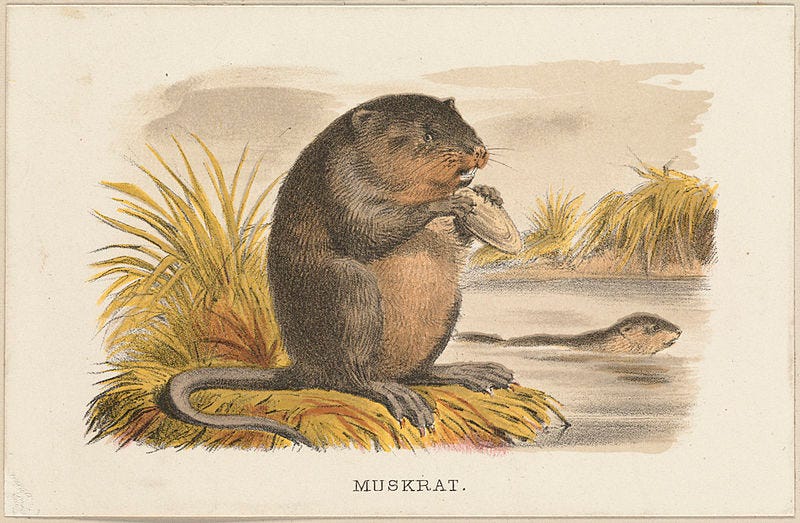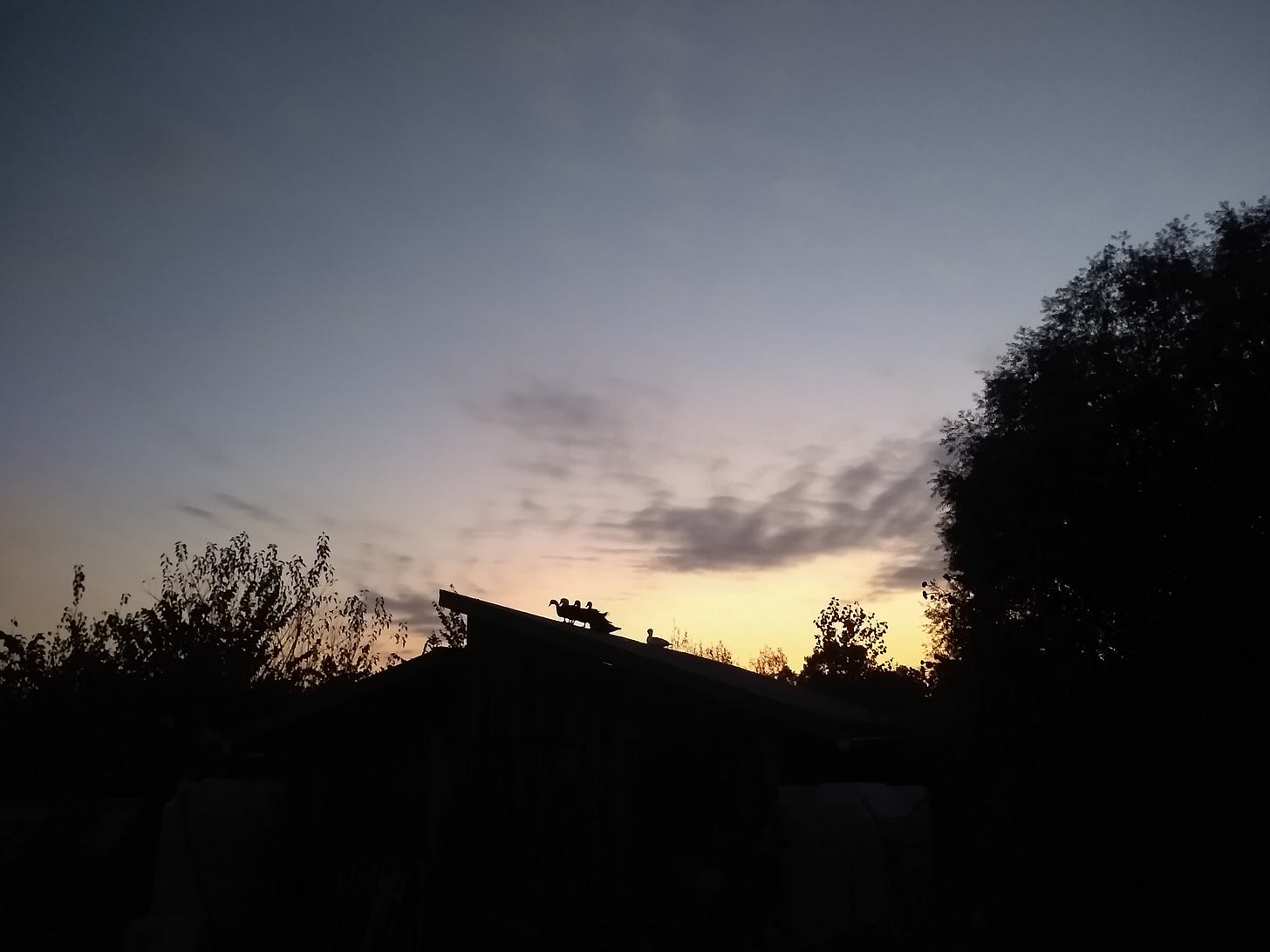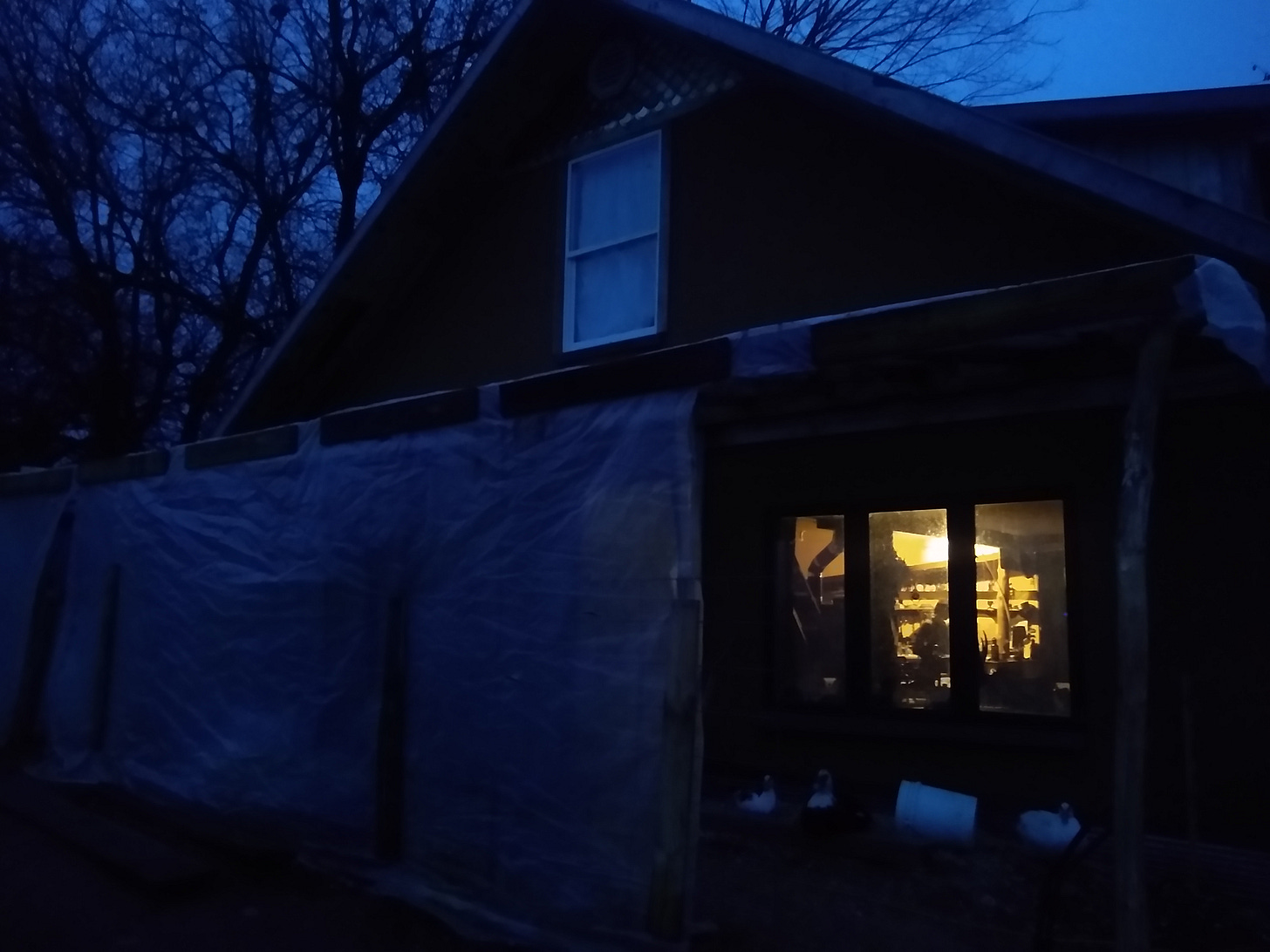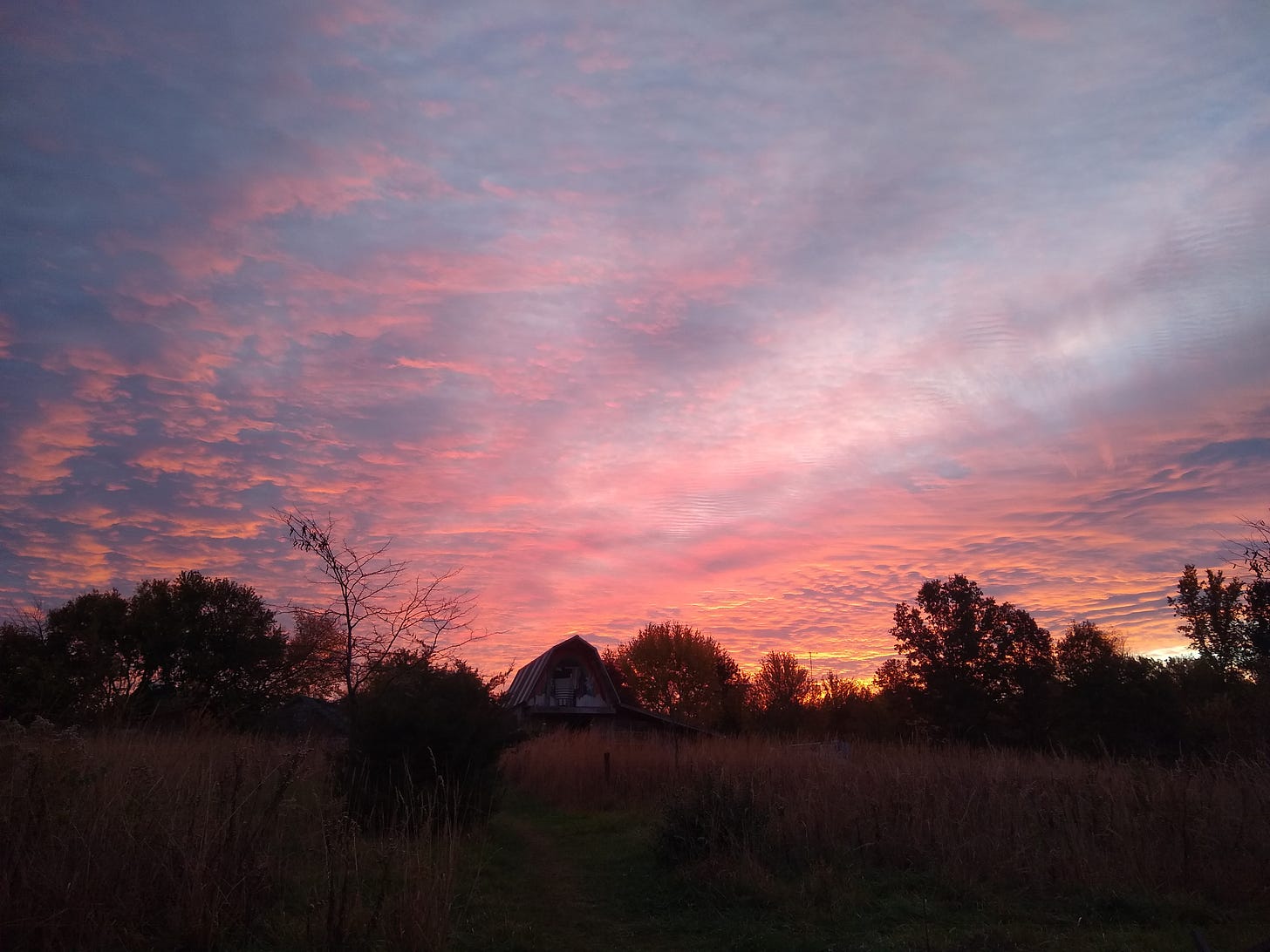Night of the Muskrat
Climate horror, grief, and the real work... plus the soothsaying abilities of semi-aquatic rodentia
Harvest equipment rattles down roadways at the end of short days, kicking up trails of fine limestone dust that mixes into the fog that condenses along the Fabius watershed river bottoms– the ghostly traces of commodities reaped from torn out prairie, howling down meandering county roads, gravel crackling under the weight of massive wheels. Plot by plot, each field has been laid bare, the surplus of grain to be weighed and inspected and assigned a monetary value, the glow of machinery taillights fading like burnt down coals through the darkening world of dust and fog and quickening dusk.
One such road, the one that leads up to our farmstead, is noticeably quiet, the patchwork of fields alongside mostly held in hay, pasture and prairie– a short, jagged stitch of gravel connecting two pot-holed traces of worn asphalt leading between nowhere and nowhere fast. We have a little bridge, which runs over a consistent pool in the otherwise ephemeral Long Branch Creek. When the creek runs high and turgid, it often hosts wood ducks and other waterfowl, but with the inevitable dry-up of summer, and what has been a concerningly droughty autumn, the pool lies low, stagnant some feet below the vegetated bank.
Some years beavers will move into the pool, chewing the willows and poplars along the bank to construct dams. In a few days, the bridge will be rumbling beneath the idling trucks of trappers. I have never once seen a beaver dam successfully flood the bottomlands of our slope here, but I would like to witness this occasional, natural, ecological event in my limited lifetime, so I respectfully and surreptitiously spring these traps, leaving the trappers’ property in place for them to retrieve. I’d like to think they believe our pool to be inhabited by beavers of higher than average intellect. I will admit that I am tempted to steal or destroy the traps at times– in spite of my agreeable personal demeanor and unassuming, average appearance, the heart of a vandal does beat within me– but these trappers mean well, by their own misinformed logic. Also, they are armed.
The construction of beaver dams might flood out (inappropriately placed) cropland, and therefore create an economic inconvenience to row-crop producers whose bottom-line is marginal– I won’t get into how current crop insurance policies incentivize these risky plantings, and how it is US taxpayers who foot the bill for these losses. This leads our trapping neighbors to believe they are offering us some service. However, damming on these small creeks and tributaries also slows the flow of rapid water movement in spring, preventing bank erosion, inundating the bottomlands with fertile silt, creating necessary habitat for other wildlife, and restoring the water table in floodplains, ensuring some degree of resilience in times of drought, and some amount of buffer from broadscale, destructive flooding in wet years, all for the price of some minor acreage of cropland which is largely intended for inefficient biofuels, feedlots, and lubricants. So, while this writer certainly would not condone damage or theft of private property, I might recommend “testing” all of the traps out, just to make sure that they work, but not resetting them, which is, afterall, a dangerous undertaking.
I have not seen beavers, or beaver traps in our pool for a few years now, but lately I have been observing at least one muskrat exploring the bridge, pool, and environs, swimming forward and backward in the low basin and skittering along the banks with cheeks full of wild vegetation. While the muskrat does not construct a dam, it does, similarly to the beaver, build lodges for the winter. Much like previous natural forecast models discussed in this almanac, like wooly bear caterpillars, yellow-billed cuckoos, cow tails, and persimmon seeds, there is some common but unproven knowledge regarding the prognostication of weather and climate based on the construction of muskrat lodges.
The common muskrat (Ondatra zibethicus) is a medium sized semi-aquatic rodent native to North America, somewhat resembling a diminutive beaver– except that while the beaver has a flat, paddle like tail, the muskrat’s tail is much thinner, and flattened slightly, 90 degrees out, almost like a rudder. Like beavers, muskrats take an active role in shaping the ecology of wetlands– chipping away banks to create more texture on the landscape, devouring cattails and water lilies, hence altering the vegetation of riparian areas, and filling a particular food niche for riparian predators. Even the vegetation used to construct their lodges is often grazed by moose in winter time. They are tolerant to sulfurous water, and can therefore provide these ecosystem services among largely uninhabitable coal mine tailings.
Many indigenous people have held a certain reverence for the muskrat. The Cree or Nehinaw people, hold that the earth’s landmass was formed by muskrats, who can be observed constructing their winter lodges with mud, debris, sticks and vegetation out in bodies of water, known sometimes as push-ups. The push-up is lined with a base of foraged vegetation which gives off heat as it composts through the cold season. Some folks have traditionally used the observation of these push-ups to forecast winter– a thick-walled lodge portends a ferociously cold season, and a tall lodge suggests that snow and precipitation will be heavy. One has to be familiar enough with muskrat housing to make these relative observations. These lodges are built anytime between September and December, and so it is said that the time that they are constructed correlates with the timing of winter’s arrival.
While I see muskrats swimming about the pool and nibbling at the edge of the bank down at our bridge from time to time, push-up construction has not begun. This week has seen temperatures in the middle-80’s– it would appear that all bets are off in determining our weather with folk models of forecast, and even once consistent scientific indicators like ocean current temperatures are less reliable in the face of climate weirdness and complexity. Still, I don’t reckon we don’t need muskrats and woolly bears to tell us things aren’t getting better.
A final sliver of sunlight burns out in the west like a waning coal, earlier and earlier each evening. The last billowing tussocks of prairie grass fade from view as the cows bed down in repose, the hogs huddle ‘neath the shelter of darkened oaks, and the nightly chorus of coyote howls and fox barks begin to ring out across our rolling slopes. The darkness will be here when I arise, more and more of it, consuming swaths of pasture, as grasses sleep and trees shudder, bare-limbed in the ceaseless wind. We do not know how long the darkness will last, ‘nor what precisely lies on the other end of it– but the muskrats tell me it seems fairly grim.
It’s Halloween, and there is no fantastic horror greater than our current reality. We stand on the precipice of a long, dark evening, as the world braces itself for an uncertain climate, politically and meteorologically. The horror has been with us for long now, stalking the field edge like crow murders waiting in the wind, hidden in the margins, stuffed further down in our news feed as every encampment bombing, atrocity, and dire scientific warning struggles for daylight in the consciousness of the affluent American public, in direct competition with the soap opera of electoral politics. This isn’t to necessarily say that electoral politics, or voting in the US isn’t important, but it’s a mere starting point in our larger work– the literal least anybody can do.
I have struggled with reckoning between my ethics as a human, and my strategy as an organizer for change, when it comes to my largely insignificant participation in this ritual of citizenship. In my state, there are deeply important ballot measures this year, and I do like getting the little sticker and stealing pens from the county clerk’s office, but if I am to merely return home after this ritual performance and passively accept that those five or so minutes of time spent filling in the little ovals is the full extent of my power, I suppose my doom would be as guaranteed as the long darkness ahead.
I am as uncertain as anybody about how the near future, let alone the distant future, is going to play out, but the muskrats tell me to expect a lot of grief, either way. And perhaps grief is an appropriate response in a nation that cannot look to its past, nor accept its current predicament. In less than a week, unless it takes much longer, we will undoubtedly be in a place of distinct division, with people who feel like winners or losers, and while life may become far worse for some targeted populations, the world will largely continue to burn regardless of the outcome. I suppose the question to ask when voting is which party would you rather organize against. The extirpation of entire cultures and ecosystems will continue either way, so grieve a moment– but then, prepare to act. No group or demographic is safe at our current level of emissions.
I have not seen muskrats down at the pool for a few days. Perhaps once the creek again swells with the forecasted rain, they will be better able to reach the vegetation held out of reach at the steep tops of the bank, provided it is not washed out in a deluge, unchecked by dams. The autumn colors these past couple of weeks have been sublime- crimson oaks, bloody sumac, gilded hedge interspersed with still verdant splashes of elder. The buck deer are in rut, and at dusk we can see them after herding our turkeys back to the safety of their wagon, snorting and rubbing in the darkness of the bottomlands.
The unusual heat which has been delaying our butchering work has finally broken, and what remains of the canopy, largely laid bare of leaf, howls in the shifting wind. This is the first October that I have not lit a fire in our house, on account of the warmth. Our quaint dwelling, surrounded on all sides by willow leaf and fallen hedge fruit and wind-snapped twigs, seems incomplete in the fall scenery without the faint plume of chimney smoke one would expect in late October. We are settling in for the long night, but something seems different.
I have a hard time recalling my nighttime dreams, but if they’re anything like my daydreams, I suppose they depict a way forward. I dream of a world in repair, where grief becomes tangible action, and people are united in the actions they take to do the necessary work of caring for each other and stewarding their home, in spite of profit and our narrow conception of survival under capitalism. In my dreams, this nation, with its outsized levels of material consumption and military presence, tunes out of the soap opera before we’re driven mad by it, and gets to work in the dirt, in all the various ways we must. It was a captivating season no doubt, but after it’s all over, we have a lot of work to do, and it doesn’t seem likely that we’re going to elect anyone to do it for us. I wipe my eyes at an unknown time of night, and think about garlic planting, the best defensive positions along the road, and muskrats.
It’s still dark when I wake, and it will remain dark for some hours. The fields have been cleared of crops, and I imagine my neighboring farmers are awake like me, waiting for the cafe to open in this narrow, eventless window between harvest season and hunting season, to doubtlessly talk politics and agronomy and fuel prices. Except for Sundays, Easter, Christmas, Ascension Day, and a few odd days back in 2020, the “Open” sign at Zimmerman’s is always sure to blink on in time for the unchanging conversation. The darkness here has not passed, but the rush of winds has shifted its course as I brew coffee outside by headlamp. A rain-moistened cover of leaves skips and twists about the thirsting dirt, and a world of wild animals is bedded down and silent as we wait to see what changed place we’ll inhabit, once dawn breaks.
Endnotes: First of all, to give credit where it is due, the themes of grief and action, explored in this latest installment of the almanac, made their way into my brain via this piece featured in The Window. As the nights grow long and I manage to get a little bit more reading in, I hope to share work from fellow writers on this platform that runs adjacent to my own. I have found myself appreciating the perspective I get on climate news by having stories curated in a bundle, rather than just reading one dreadful story at a time, so thanks for putting it together, Twilight!
Long nights also mean short days, and I have a lot to accomplish in them this time of year. You may have noticed that this piece was a few days late— I am doing my best to balance farming, writing, and family in a very busy, transitional season. Thanks for your understanding and patience. It might be easier to publish more reliably if every entry didn’t have to be such a damned tome… oh well. See you on the other side of darkness!






